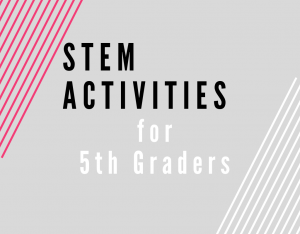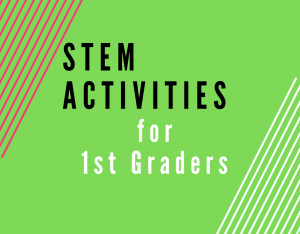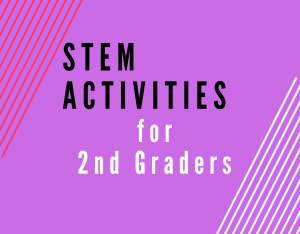If you’re looking for STEM activities for your kindergartener, you’ve come to the right place. Research has revealed that early childhood is the best time to be introduced to STEM. That is because from birth to age 5, neural connections are being made. When STEM concepts are learned at this age, a foundation in STEM learning is acquired for the years to come.
STEM education is an interdisciplinary approach to learning science, technology, engineering, and math. This means that many STEM projects will combine subjects. This does not mean that the more subjects the STEM activity combines, the better it is. It simply points out the nature of the project includes them. As the years progress, STEM will become more individually focused. This comes with students’ liking in a particular subject, allowing them to follow that career path equipped with a background in the other STEM fields.
In my years researching STEM trying to discover programs to facilitate at my library, I have found the best and most effective STEM projects that work for me and my colleagues. Many sources online don’t seem to get the integrated and interdisciplinary nature of STEM, but I have found a wonderful book that does. It’s called Baby Steps to STEM by Jean Barbre. Nearly all the activities in the book are great, but I chose these because I have seen them be successful in getting the concepts across to the students while they enjoy doing them.
Table of Contents
Farm Fresh
STEM Concepts
- Science (Life science, Earth Science)
- Technology (Simple tools)
- Math (Classification)
Materials
- Books about farms and crops
- Variety of fruits and vegetables
- Knives
- Cutting board
- Paper plates
- napkins
Learning Outcome
Farms can produce fruits and vegetables and a variety of other crops. Air, water, and soil is needed for crops to grow. Children will learn what fruits and vegetables grow on a farm and the environment’s role in helping crops grow.
How To
Read books about what grows on a farm and discuss. Food from Farms by Nancy Dickmann, Eating the Alphabet: Fruits and Vegetables from A to Z by Lois Ehlert, and From the Garden: A Counting Book About Growing Food by Michael Dahl and Todd Ouren are a few examples but almost any book from the 630 call number section in your local children’s library would do. On the day of the activity, cut some fruit and vegetables beforehand for children to taste. Make sure not to cut at least one fruit and vegetable so the children can taste them in their whole state.
What To Say and Ask
- A farm is where fruits and vegetables grow. Today, we are going to examine some fruits and vegetables and see how they taste.
- Here is a [name of fruit or vegetable]. What color is it? How does it taste?
- Which fruit or vegetable did you like the most? Why did you like it the most?
Icy Mountains
STEM Concepts
- Science (Physical science, Life science, Earth science)
- Technology (Simple tools)
- Engineering (Engineering)
- Math (Number sense, Measurement, Mathematical reasoning)
Materials
- Water
- Variety of containers in which to freeze water, such as gelatin molds, plastic storage boxes, muffin tins, ice cube trays
- Photos of mountains
- Camera
- Small toys
- Bowls of water
- Salt
- Several large buckets
- Items for pouring water such as plastic cups, sponges, turkey basters, funnels
Learning Outcome
The freezing point of water can be lowered by salt, the ice briefly melts and then freezes again. Children will be introduced to the properties of water as they build an ice mountain. They will also find out what happens when you put salt on top of ice.
It is important to comment that salt can’t melt ice by itself. It must be combined with water first to start melting.
How To
Gather all the containers for freezing water and make enough room in the freezer for containers.
Day 1: Explain that you are going to build an ice mountain as you show the children pictures of mountains. Organize the empty containers that you are going to use to fill water in and invite the children to count and sort them. Help the children in creating a plan or model for building their mountain using the empty containers. Document the model by taking photos. This is needed for the construction on day 2. Discuss the properties of water and ask for the children’s predictions on the toy items in ice cube trays, gelatin molds, or ice molds, then fill with water and freeze overnight.
Day 2: Review the plan made the previous day with the children. Taken the frozen water out of the molds and put them into different buckets. Sprinkle the salt onto the ice in the buckets and let the children build mountains of ice. Allow the children to use the items for pouring to add more water to help melt the ice and let them play with the water. Once the ice has melted, collect all the small toys and sort and count them. Document the processes as they build.
Hint: Keep a bucket of warm water available in case hands get too cold. Always closely monitor young children to make sure they don’t put small objects in their mouths.
What To Say and Ask
- You counted the items. How many are there?
- What do you think is going to happen to this item in the water overnight?
- Which item do you want to freeze first? Which container should we put it in?
- Do you think the object will float or sink? Why?
- We can stack the pieces on top of each other to build a mountain. Let’s try it out.
- I am going to sprinkle salt on the ice. Let’s see what happens.
- What is happening?
- Now, the ice is melting.
- What is it turning into now? You are correct! When the ice melts, it turns into water again!
Fall Nature Prints
STEM Concepts
- Science (Physical science, Life science, Earth science)
- Technology (Simple tools)
- Math (Patterns and classification)
Materials
- Variety of leaves
- Magnifying glass
- Colored pencils
- Crayons
- Clipboards
- Different kinds of paper, including tracing paper, parchment paper, or wax paper
- Tape
Learning Outcome
The rubbings off of leaves give children a closer look at the structure of the leaf, including the stem, leaf, and veins. The leaves in most plants provide food for the plant. The veins transport food, water, and minerals to the plant. Children will investigate and explore leaves through their parts as they experience life science and the natural world.
How To
After collecting the leaves, use the magnifying glass to allow children to investigate them. Introduce the children to the different coloring materials. Place a leaf and paper on each clipboard, with the paper covering the leaf. As the child rubs the paper with the coloring materials, the clipboard will keep them in place. Allow the children to experiment with the rubbings by using different types of paper and coloring materials. Each coloring tool used on the paper’s surface will give different kinds of leaf rubbing experiences. Tape the leaf rubbings to windows to let the light show through the paper. Tape the natural leaf up to the leaf rubbing to show the difference.
Hint: Warn children that it’s easy to tear the paper, so it is important not to press or rub too hard. Paper that is thinner will rip easier.
What To Say and Ask
- Where were the leaves before we were able to collect them? Yes, they were outside on the trees, and we picked the ones that had fallen to the ground.
- How do the leaves look the same as each other?
- How do the leaves look different?
- Look at the edges of the leaves. How are they different?
- What colors do you see in the leaves?
- This one is brown and green. What else do you notice on the leaf?
- What does it feel like when you touch it?
See and Taste
STEM Concepts
- Science (Life science, Earth science)
- Technology (Simple tools)
- Math (Number sense and operations, Patterns and classification)
Materials
- Fresh fruits and vegetables
- Knife
- Cutting board
- Tray or baking sheet
- Paper towels
- Napkins or small paper plates
- Magnifying glass
Learning Outcome
There are many types of fruits and vegetables. Edible plants have a root, fruit, leaves, or flower. Fruits are the part of the plant that has seeds. Because they contain seeds, vegetables such as cucumbers or tomatoes are sometimes seen as the fruit of the plant. Lettuce and spinach are leaves of plants. Vegetables such as carrots or potatoes are identified as the root of the plant as they grow underground. Cabbage, broccoli, and cauliflower, among other vegetables, are identified as the flower of a plant. Children will explore and investigate different kinds of fruits and vegetables as they through their senses.
How To
Put paper towels on the tray or baking sheet. One at a time, introduce the fruits and vegetables to the children. Before you cut them, let them look, feel, and smell the individual fruits and vegetables. You may want to introduce fruits separately from vegetables. Keep unhandled fruits and vegetables aside for sampling later. Inform the children where fruits and vegetables grow and that they need water, air, soil, and nutrients to grow. Describe the skin or peel of fruits and vegetables. Cut the fruits and vegetables so children can see and feel the flesh or pulp. Using the magnifying glass, allow the children to examine the fruits and vegetables while pointing out the seeds.
What To Say and Ask
- Let’s look at the strawberries.
- Who has ever eaten a strawberry?
- What color is this strawberry?
- Using the magnifying glass, what do you see when you look at it? Yes, there are tiny seeds on it.
- What color is the tomato?
- What do you see when I cut it the tomato in half? Yes, there are seeds inside it.
- What color is the watermelon?
- Is the watermelon heavier or lighter than the strawberry?
Orange Sail
STEM Concepts
- Science (Physical science, Life science)
- Technology (Simple tool)
- Math (Number sense)
Materials
- 2 oranges water medium-size clear plastic container
- Magnifying glass
Learning Outcome
Depending on its density and mass, objects either sink or float. The trapped air that is between the flesh of the orange and the orange peel is the cause of the unpeeled orange to be buoyant and float. Buoyancy is the force that makes an object rise upward when placed in water compared to an object that sinks in water. Children will experience and learn the concepts of sink and float.
How To
Fill a clear plastic container with water. Ask children what they know about oranges. Discuss the taste, shape, and color of them, and explain how oranges grow on trees. Pass the oranges around so children can experience the outside. Peel one of the oranges, keeping the skin for later investigation. Ask the children to smell and feel the unpeeled orange. Ask the children if they think the orange with its skin on or with its skin off will sink or float. Put both of the oranges in the water. Using the magnifying glass, allow the children to examine the inside of the orange and its peel more closely. Document the children’s predictions and the results.
What To Say and Ask
- Take a look at this orange. It has skin on the outside. Let’s see what we can observe about its skin.
- How does the skin feel?
- What do you know about oranges?
- What does the orange look like?
- How does the orange feel?
- How does the orange smell?
- Which orange do you think will float or sink? The one with the skin on or the one with the skin off?
- Let’s put the oranges in the water. Why do you think this orange floated? Why do you think this orange sank?
Color Jar
STEM Concepts
- Science (Physical science)
- Technology (Simple tools)
- Engineering (Engineering)
- Math (Number sense and operations, Measurement)
Materials
- 6 large, clean, clear glass containers, such as Mason jars
- Honey
- Blue or green dishwashing soap
- Water
- Vegetable or olive oil
- Rubbing alcohol
- Food coloring
- Measuring cup
- Magnifying glass
Learning Outcome
Some combinations of liquids will mix, and others won’t if you pour them together. Each liquid’s level of density determines if they will mix or will not. The liquid with the lowest density will be on top while the liquid with the highest density will stay on the bottom. Children will learn about different liquids and how each liquid has a different density. Liquids also feel and smell different.
How To
Pour each of the five liquids into a separate container and line them up in order: first is honey, second is dishwashing soap, third is water, fourth is the vegetable or olive oil, and fifth is rubbing alcohol.
Add food coloring to each of the liquids: purple to honey; blue to the dishwashing soap; green to the water; yellow to the vegetable or olive oil; and red to the rubbing alcohol. They will look like a rainbow. Discuss each of the liquids, letting children feel and smell all except the rubbing alcohol before adding it to the container. Talk about and document the differences they are experiencing. Measure ⅓-¼ cup of each liquid. First, pour the purple honey into the jar and then the blue dishwashing soap. Next, slowly pour the green water down the sides of the jar. Then pour in the yellow vegetable or olive oil and the rubbing alcohol down the sides of the container. Allow the children to examine the rainbow layers using the magnifying glass.
What To Say and Ask
- We’re going to pour each of these liquids into this container
- The liquids are different from each other. Let’s watch and see what happens.
- Let’s smell this liquid.
- How does this liquid feel?
- When we add the next liquid, what do you notice? A new layer of liquid is correct!
- Compared to that liquid, how does this liquid feel? This liquid is heavier or denser than that one.
- Let’s count the colors.
Source
Barbre, Jean. Baby Steps to STEM: Infant and Toddler Science, Technology, Engineering, and Math Activities.Redleaf Press, 2017.



